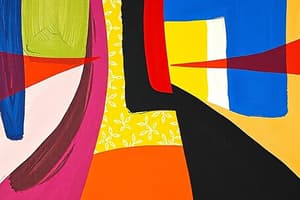Podcast
Questions and Answers
What is a characteristic feature of the Renaissance movement in arts?
What is a characteristic feature of the Renaissance movement in arts?
- Focus on realism and humanism (correct)
- Experimentation with light and movement
- Emphasis on abstract forms and non-representational art
- A rejection of classical influences
Which of these is NOT considered a visual art form?
Which of these is NOT considered a visual art form?
- Painting
- Dance (correct)
- Sculpture
- Photography
What is the primary focus of applied arts?
What is the primary focus of applied arts?
- Exploring abstract themes and concepts
- Artistic creation with a focus on functionality (correct)
- Creating aesthetically pleasing artworks
- Expressing deep emotional narratives
Which principle of design refers to the distribution of visual weight in an artwork?
Which principle of design refers to the distribution of visual weight in an artwork?
Which artist is best known for his contributions to Cubism?
Which artist is best known for his contributions to Cubism?
What does modernism in arts generally signify?
What does modernism in arts generally signify?
What is a key element of art?
What is a key element of art?
Which art form primarily emphasizes sound and rhythm?
Which art form primarily emphasizes sound and rhythm?
Study Notes
Overview of Arts
- Definition: Arts encompass various human activities that involve the creation of visual, auditory, or performance artifacts intended to express the creator’s imagination or technical skill.
Major Art Forms
-
Visual Arts
- Painting: Use of pigments on surfaces.
- Sculpture: Three-dimensional works made from materials such as stone, metal, or clay.
- Photography: Capturing images using light-sensitive materials.
- Drawing: Creating images primarily using pencils, ink, or charcoal.
-
Performing Arts
- Theater: Live performance of plays, including acting, live music, and dance.
- Dance: Expressive movement often set to music.
- Music: Art form involving sound, rhythm, melody, and harmony.
-
Literary Arts
- Poetry: Compressed language that emphasizes sound and rhythm.
- Fiction: Narrative literature that includes novels and short stories.
- Drama: Written works designed for performance.
-
Applied Arts
- Design: Artistic creation focused on functionality (e.g., graphic design, industrial design).
- Crafts: Handicrafts which include ceramics, textiles, and jewelry.
Importance of Arts
- Cultural Expression: Reflects and shapes cultural identity and societal values.
- Emotional Impact: Evokes a range of emotions and can serve therapeutic purposes.
- Critical Thinking: Encourages analysis, interpretation, and appreciation of creativity.
Notable Movements in Arts
- Renaissance: Revival of classical learning and art; emphasis on realism and humanism.
- Impressionism: Focus on light and movement; spontaneity in painting.
- Modernism: Break from tradition; experimentation with form and technique.
- Postmodernism: Challenges established norms; embraces diversity and irony.
Art Appreciation
- Elements of Art: Line, shape, color, texture, space, form, and value.
- Principles of Design: Balance, contrast, emphasis, movement, pattern, rhythm, and unity.
Famous Artists
- Pablo Picasso: Co-founder of Cubism, known for his diverse styles.
- Vincent van Gogh: Influential post-impressionist known for emotive use of color.
- Leonardo da Vinci: Renowned for masterpieces like "Mona Lisa" and "The Last Supper".
- Frida Kahlo: Celebrated for her self-portraits and exploration of identity and pain.
Conclusion
- The arts are a vital aspect of human experience, reflecting societal changes and personal narratives. They play a crucial role in fostering creativity, cultural awareness, and emotional well-being.
Overview of Arts
- Arts are human activities creating visual, auditory, or performance artifacts
- Expresses creator's imagination and technical skill
Major Art Forms
Visual Arts
- Painting: Using pigments on surfaces
- Sculpture: Three-dimensional works made from materials like stone, metal, or clay
- Photography: Capturing images using light-sensitive materials
- Drawing: Creating images primarily using pencils, ink, or charcoal
Performing Arts
- Theater: Live performance of plays, including acting, live music, and dance
- Dance: Expressive movement often set to music
- Music: Art form involving sound, rhythm, melody, and harmony
Literary Arts
- Poetry: Compressed language emphasizing sound and rhythm
- Fiction: Narrative literature, including novels and short stories
- Drama: Written works designed for performance
Applied Arts
- Design: Artistic creation focused on functionality (e.g., graphic design, industrial design)
- Crafts: Handicrafts such as ceramics, textiles, and jewelry
Importance of Arts
- Cultural Expression: Reflects and shapes cultural identity and societal values
- Emotional Impact: Evokes a range of emotions and can serve therapeutic purposes
- Critical Thinking: Encourages analysis, interpretation, and appreciation of creativity
Notable Movements in Arts
- Renaissance: Revival of classical learning and art; emphasized realism and humanism
- Impressionism: Focus on light and movement; spontaneity in painting
- Modernism: Break from tradition; experimented with form and technique
- Postmodernism: Challenged established norms; embraced diversity and irony
Art Appreciation
- Elements of Art: Line, shape, color, texture, space, form, and value
- Principles of Design: Balance, contrast, emphasis, movement, pattern, rhythm, and unity
Famous Artists
- Pablo Picasso: Co-founder of Cubism, known for his diverse styles
- Vincent van Gogh: Influential post-impressionist known for emotive use of color
- Leonardo da Vinci: Renowned for masterpieces like "Mona Lisa" and "The Last Supper"
- Frida Kahlo: Celebrated for self-portraits and exploration of identity and pain
Conclusion
- Arts are essential to human experience, reflecting societal changes and personal narratives
- Foster creativity, cultural awareness, and emotional well-being
Studying That Suits You
Use AI to generate personalized quizzes and flashcards to suit your learning preferences.
Description
Explore the diverse world of arts through this quiz, which covers various forms including visual, performing, and literary arts. Dive into the definitions, characteristics, and examples of each art form to enhance your understanding of artistic expression.




